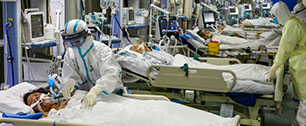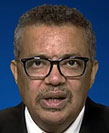DIARY OF THE
COVID-19 PANDEMIC
Who did and said what and when…
Up to end January 2020
July 2019
Boris Johnson, the new Prime Minister, scrapped (with no publicity) the team of senior ministers, chaired by the PM, charged with preparing the country for a pandemic. The committee, known as the Threats, Hazards, Resilience and Contingency Committee (THRCC), a sub-committee of the National Security Council, had earlier been suspended by former prime minister Theresa May so that civil servants and ministers could focus on plans for the UK’s departure from the European Union. [Appendix 1]
 31st December 2019
31st December 2019
Wuhan Municipal Health Commission, China, reported a cluster of cases of pneumonia in Wuhan, Hubei Province. A novel coronavirus was eventually identified. It was later reported that the first case had occurred in November or possibly even earlier.
1st January 2020
WHO set up the IMST (Incident Management Support Team) across the three levels of the organisation: headquarters, regional headquarters and country level, putting the organisation on an emergency footing for dealing with the outbreak.
2nd January
Boris Johnson declared that 2020 “is going be a fantastic year for Britain”.
• “Fantastic” proved a good choice of word.
3rd January
Professor Zhang Yongzhen began to sequence the first COVID-19 genome in the Shanghai Public Health Clinical Centre in China from swabs taken from a patient in Wuhan suffering from what was described as a peculiar type of pneumonia. This work was completed early on 5th January. He determined the virus was about 80% related to SARS – and highly dangerous. He informed Wuhan Central Hospital of his findings, describing the virus as more dangerous than influenza and Asian Flu H5N1 and said it was transmitted via the respiratory tract. He uploaded the genome to the US National Centre for Biotechnology Information that same day. After checks by government officials in Beijing, his findings were published on 11th January. Although there was mounting evidence of person-to-person transmission, including doctors catching it, it took until 20th January for China to officially confirm community transmission and on 22nd January Wuhan began a 76-day lockdown. China was widely criticised for delaying the start of the lockdown.
4th January
WHO reported on social media that there was a cluster of pneumonia cases – with no deaths – in Wuhan, Hubei province.
5th January
WHO published its first Disease Outbreak News on the new virus. This is a flagship technical publication for the scientific and public health community as well as global media. It contained a risk assessment and advice, and reported on what China had told the organisation about the status of patients and the public health response on the cluster of pneumonia cases in Wuhan.
10th January
WHO issued a comprehensive package of technical guidance online with advice to all countries on how to detect, test and manage potential cases, based on what was known about the virus at the time. This guidance was shared with WHO’s regional emergency directors to share with WHO representatives in countries.
Based on experience with SARS and MERS and known modes of transmission of respiratory viruses, infection and prevention control guidance was published to protect health workers, recommending droplet and contact precautions when caring for patients, and airborne precautions for aerosol-generating procedures conducted by health workers.
12th January
China publicly shared the genetic sequence of COVID-19.
13th January
Officials confirmed a case of COVID-19 in Thailand, the first recorded case outside of China. The infected individual had travelled there from Wuhan. [Appendix 6]
14th January
WHO’s technical lead for the response noted in a press briefing that there may have been limited human-to-human transmission of the coronavirus (in the 41 confirmed cases), mainly through family members, and that there was a risk of a possible wider outbreak. The lead also said that human-to-human transmission would not be surprising given its experience with SARS, MERS and other respiratory pathogens.
15th January
Japan reported its first case, also in a person who had visited Wuhan. [Appendix 6]
20th-21st January
WHO experts from its China and Western Pacific regional offices conducted a brief field visit to Wuhan.
21st January
The first case in the United States appeared in a man in his 30s who returned from Wuhan to Washington State.
22nd January
The WHO mission to China issued a statement saying there was evidence of human-to-human transmission in Wuhan but more investigation was needed to understand the full extent of transmission.
22nd January
First meeting of the UK government’s SAGE (The Scientific Advisory Group for Emergencies) on what was referred to at the head of the minutes as the “Wuhan virus”. SAGE exists to advise the UK government in emergencies; it is usually chaired jointly by the UK’s chief scientific adviser and the chief medical officer and is comprised of specialists from academia and industry, along with “experts” from within government. In this and subsequent meetings (usually two a week from this point onwards) the committee discussed scientific, health and behavioural issues and agreed some actions and gave advice.
Eighteen “scientific experts” attended this first meeting, along with five “observers and government officials”, plus members of the group’s secretariat, and discussed the outbreak in Wuhan and considered conclusions from NERVTAG, the New and Emerging Respiratory Virus Threats Advisory Group which advises the government on the threat posed by new and emerging respiratory viruses. [Appendix 2]
22nd-23rd January
 The WHO director-general, Dr Tedros Adhanom Ghebreyesus, convened an Emergency Committee under the International Health Regulations (IHR 2005) to assess whether the outbreak constituted a public health emergency of international concern. The independent members from around the world could not reach a consensus based on the evidence available at the time. They asked to be reconvened within 10 days, after receiving more information.
The WHO director-general, Dr Tedros Adhanom Ghebreyesus, convened an Emergency Committee under the International Health Regulations (IHR 2005) to assess whether the outbreak constituted a public health emergency of international concern. The independent members from around the world could not reach a consensus based on the evidence available at the time. They asked to be reconvened within 10 days, after receiving more information.
24th January
A paper in The Lancet, entitled “A novel coronavirus outbreak of global health concern”, assessed the lethal potential of the virus, suggesting it was comparable to the Spanish flu epidemic of 1918, and advised: “Every effort should be given to understand and control the disease, and the time to act is now.”
28th January
A senior WHO delegation led by the director-general travelled to Beijing to meet China’s leadership, learn more about China’s response, and to offer any technical assistance. While in Beijing, Dr Tedros agreed with Chinese government leaders that an international team of leading scientists would travel to China on a mission to better understand the context, the overall response, and exchange information and experience.
29th January
First confirmed cases of coronavirus in the UK: two Chinese nationals fell ill at the Staycity Aparthotel in York. On 6th February, a British businessman in Brighton was diagnosed with the virus after catching it in Singapore; he was subsequently linked to 11 other cases, five in the UK. On 28th February, the first person believed to have caught coronavirus in the UK was diagnosed: a man who lived in Surrey but had not been abroad. It was later revealed, however, that a 75-year-old woman from Nottinghamshire caught the disease on 21st February and was thought to have been the first fatality in the UK (see entry for 9th September regarding an earlier fatality).
30th January
The WHO director-general reconvened the Emergency Committee. This was earlier than the 10-day period and only two days after the first reports of limited human-to-human transmission were reported outside China. This time, the committee reached consensus and advised the director-general that the outbreak constituted a Public Health Emergency of International Concern (PHEIC). The director-general accepted the recommendation and declared the novel coronavirus outbreak (2019-nCoV) a PHEIC. This was the 6th time WHO had declared a PHEIC since the International Health Regulations (IHR) came into force in 2005.
WHO’s situation report for 30th January reported 7,818 total confirmed cases worldwide, with the majority of these in China, and 82 cases reported in 18 countries outside China. WHO gave a risk assessment of very high for China, and high at the global level.
More than 50 academic papers about COVID-19 had been published in English-language journals, including The Lancet, by 30th January.
30th January
The four chief medical officers of the UK raised the perceived risk level in the UK from low to medium.
31st January
US President Donald Trump announced restrictions on flights from China to America.
Copyright © 2020 GD Ritchie
All rights reserved